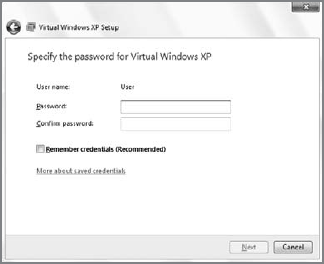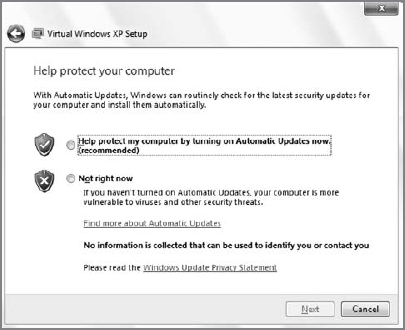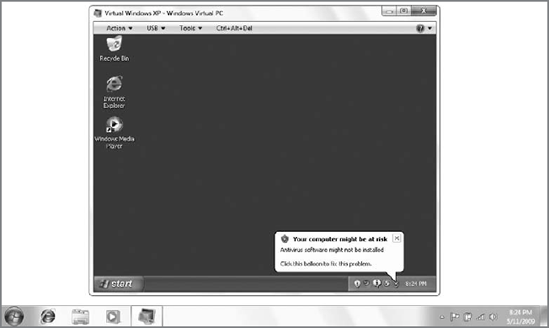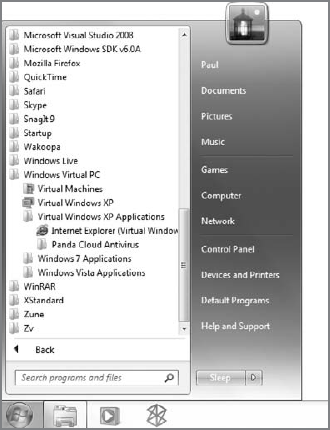4.2.2. Taking It to the Next Level: Windows XP Mode
For users of Windows 7 Professional, Enterprise, and
Ultimate, Microsoft provides a freely downloadable, prepackaged, and
fully licensed copy of Windows XP with SP3 as a perk. Called Windows XP
Mode, this feature allows you to run XP applications side by side with
Windows 7 applications using Windows Virtual PC. Yeah, it really is
that cool.
When you download and install Windows XP Mode and
run it for the first time, you are prompted to provide a non-optional
password for the default user account in Windows XP, which is
imaginatively titled User (see Figure 18).

The more important option is Remember credentials
(recommended). We, too, recommend that you select this option, as the
point of XP Mode is that you can seamlessly run XP applications
side-by-side with Windows 7 apps. If you do not allow the system to
remember your logon credentials (for example, your user name and
password), you will be prompted to provide them every time you run an
XP application.
You're also prompted to configure Automatic Updates, as shown in Figure 19.
Again, you should do so, as you want the underlying XP system to take
care of itself. After initial configuration, you should be able to
forget it even exists for the most part.

After this, you will have to wait quite a while as
Windows Virtual PC steps through the process of starting the virtual
machine, setting up Windows XP Mode for first use, starting the OS, and
enabling integration features. What's happening behind the scenes is
that Windows Virtual PC is actually moving through the post-Setup
steps, creating the user and configuring the Automatic Updates setting
you previously defined. When it's ready, the familiar Windows XP
Desktop will appear in a window on top of your Windows 7 Desktop, as
shown in Figure 20.
Of course, running a virtual environment inside of a
host OS like Windows 7 isn't the end goal here. The reason you're
running Windows XP virtually in the first place is that you want access
to that system's larger (and older) software library. From here on out,
any application you install under Windows XP will actually appear in
the Windows 7 Start menu, as shown in Figure 21.
In this way, XP Mode is publishing
installed applications to Windows 7. And when you run these apps from
the Windows 7 Start menu, naturally, they run side-by-side with native
Windows 7 applications, share the same clipboard and file system with
the host environment, and so on. And really, that's the point: XP Mode
isn't about running Windows XP. It's about getting incompatible
applications to work properly again.


NOTE
It's not obvious, but this ability to run
virtual applications inside of Windows 7 is not limited to Windows XP
Mode. Nor is it limited to virtualized instances of Windows XP. You can
do the same thing with virtualized Windows Vista and Windows 7
applications, too.
NOTE
Publishing applications is nice, but what about
XP's built-in apps, like Internet Explorer 6? You can manually publish
built-in Windows XP apps using the following workaround: launch Windows
XP Mode, right-click the XP Start menu, and choose Open All Users. In
the Explorer window that appears, navigate into the Programs folder.
Now, drag a shortcut for the application you'd like to run into the
Programs folder. Close it, close XP Mode, and check the Windows 7 Start
menu: success!
4.2.3. Looking to the Future
As it stands today, Windows Virtual PC is an
interesting and, in many cases, desirable solution, especially with
Windows XP Mode. But the underlying technology is still based on the
legacy Virtual PC code and not on newer, hypervisor-based
virtualization solutions like Hyper-V, part of the Windows Server 2008
product line. This technology runs closer to the metal than Windows
Virtual PC, so it offers much better performance and is more secure and
easily maintainable. Despite utilizing a different architecture,
however, Hyper-V is compatible with the same VHDs used by Windows
Virtual PC, ensuring that customers who adopted Microsoft's
virtualization products early in the game could move their virtualized
environments forward.
Microsoft also offers more managed application
virtualization products, which today are, of course, geared toward
larger companies. Microsoft purchased a company called SoftGrid and
relaunched its application virtualization solution as Microsoft
Application Virtualization, or App-V. This software enables Microsoft
customers to stream applications to the desktop in special virtualized
packages. Instead of delivering an entire virtualized environment to
end users, companies can deliver individual applications in a package,
along with any required dependent files. These packages break the
application/operating system lock and allow for some interesting
scenarios, including the ability to run multiple versions of the same
application on a single OS.
Then, in 2007, Microsoft purchased another
innovative company in the virtualization space, Kidaro. This
acquisition gave Microsoft the final piece of the puzzle: the ability
to combine the power of Virtual PC with the application independence of
SoftGrid. The resulting product, Microsoft Enterprise Desktop
Virtualization (MED-V), is basically a server-based version of XP Mode.
Looking ahead, it seems like future versions of
Windows will include a virtualization solution based on Hyper-V and
some combination of the SoftGrid and Kidaro technologies. This would
expand on the work done in Windows 7 but provide additional performance
and manageability benefits. Then, in these future Windows versions,
Microsoft will be able to move in completely new technical directions,
secure in the knowledge that its virtualization platform will enable
users to install virtually (sorry) any application that works on older
versions of Windows. The key is packaging them into mini-virtualized
environments that include only those parts of Windows XP, Windows 98,
or whatever they need in order to run.
Windows Virtual PC and Windows XP Mode are just one step down this road. They are an important step, of course.